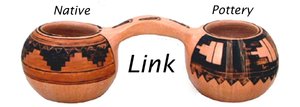
Jemez Pottery
Native American Jemez Pueblo pottery storyteller koshare in Pueblo clay. For this storyteller, Janeth Fragua has created a koshare with three mini koshares, painted in black, rust and tan colors and holding corn husks.
Koshares are Pueblo clowns (sometimes called sacred clowns). They are jesters or tricksters in the Kachina religion (practiced by the Pueblo natives of the southwestern United States).
P398 Jemez Pueblo Janeth Fragua pottery koshare storyteller. 7" tall
$390.00
Native American Jemez Pueblo pottery storyteller koshare in Pueblo clay. For this storyteller, Janeth Fragua has created a koshare with three mini koshares, painted in black, rust and tan colors and holding corn husks.
Janeth was born in 1964, a daughter of Rose Fragua. She has been creating pottery since 1984. Janeth is very prolific at building, painting and firing storytellers, koshares and friendship bowls typically painted in black and rust colors.
Koshares are Pueblo clowns (sometimes called sacred clowns). They are jesters or tricksters in the Kachina religion (practiced by the Pueblo natives of the southwestern United States).
7" tall #P398
Please Note: For a limited time, our normal $50 fee for packing and shipping will be absorbed by Native-PotteryLink, resulting in free shipping to any address within the 48 mainland United States. Shipping to other destination may be arranged by emailing Sanibelart@gmail.com.



